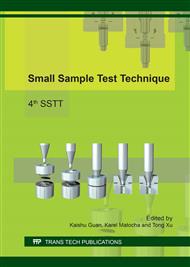p.168
p.176
p.185
p.194
p.202
p.206
p.212
p.237
p.251
An Alternative Method for Strain-Controlled Fatigue Test at Elevated Temperature
Abstract:
For strain-controlled fatigue tests, especially at elevated temperature, implementation of knife-edges and punching dimples within gauge length of specimen may cause premature failure on the test section. In this paper, an alternative approach is introduced to control and measure the strains in fatigue tests. Two dimples outside the gauge length section are punched and used to mount the extensometer. The correlation between the controlled (measured) strain and the strain within the gauge length section is established. By comparing the hysteresis loops obtained through the correlation and the one directly measured within the gauge length, it is found that the established correlations are in good agreement with the latter result.
Info:
Periodical:
Pages:
202-205
Citation:
Online since:
April 2017
Authors:
Price:
Сopyright:
© 2017 Trans Tech Publications Ltd. All Rights Reserved
Share:
Citation:


